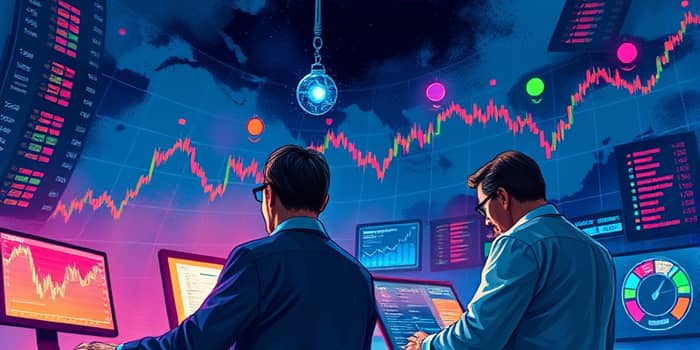Futures contracts serve as vital tools in modern finance, empowering participants to manage risk, speculate on price movements, and discover fair market values.
Definition and Basics of Futures Contracts
A futures contract is a standardized agreement to buy or sell an underlying asset at a predetermined price on a specified future date.
As a derivative, its value is derived from commodities, financial instruments, indices, or currencies. The agreement obligates both parties—buyer (long) and seller (short)—to fulfill the trade regardless of price changes at expiry.
Key contract terms include:
- Specified quantity of the asset to be delivered or settled
- Agreed-upon purchase or sale price
- Defined expiry and delivery date
- Quality specifications, especially for commodities
- Settlement method: physical delivery or cash
Types of Futures Contracts
Futures markets have evolved to cover a broad range of instruments, catering to diverse needs:
- Commodity futures: Gold, oil, agricultural products—essential for price risk management by producers and consumers.
- Financial futures: Stock indices, interest rates, and government bonds used in portfolio hedging and macroeconomic speculation.
- Currency futures: Facilitate future exchange of one currency for another, guarding against exchange rate swings.
- Stock futures: Allow speculation and risk mitigation on individual share prices.
- Interest rate futures: Hedge against bond yield fluctuations, often tied to treasury notes.
- Stock index futures: Traded on major indices like S&P 500 and Nasdaq for broad market exposure.
Futures Trading Mechanics
Trading futures involves specialized processes and safeguards to maintain market integrity:
- Margin and leverage: Traders post an initial margin (3%–12% of contract value), unlocking amplified exposure with modest capital.
- Marking to market: Accounts are adjusted daily to reflect gains or losses, reducing counterparty risk.
- Lot size: Standardized by exchanges—e.g., 100 barrels of crude oil per contract.
- Expiry and settlement: Some contracts deliver the physical asset; others settle in cash, offering convenience for financial instruments.
- Rollover: To maintain positions beyond expiry, traders roll contracts into later months.
Purposes and Market Participants
Futures markets attract three primary groups, each with distinct objectives:
- Hedgers: Commercial producers and consumers—farmers locking in crop prices or airlines hedging fuel costs—to secure budgets against volatility.
- Speculators: Traders seeking profit from price shifts, providing liquidity but assuming market risk.
- Arbitrageurs: Exploit price gaps between futures and spot markets, ensuring efficient price discovery across venues.
Exchange Infrastructure and Regulatory Framework
Most futures trade on centralized exchanges, such as CME Group, NYMEX, and COMEX, which standardize contracts and oversee clearing through central counterparties.
In the U.S., the Commodity Futures Trading Commission (CFTC) enforces rules to protect market integrity. The National Futures Association (NFA) regulates members, mandates customer fund segregation, and requires risk disclosures.
These measures create a robust environment where traders benefit from transparency, low default risk, and strict oversight of trading practices.
Options on Futures
Options on futures enhance flexibility by granting the right, but not the obligation, to enter into a futures position at a preset strike price before expiration.
Calls offer the right to buy a futures contract, while puts grant the right to sell. Traders price options using models like the Black model, adapting the Black-Scholes framework to futures volatility and time decay.
This layered structure allows intricate strategies, such as spreads and collars, to tailor risk–reward profiles.
Liquidity, Trading Hours, and Tax Considerations
Major futures contracts like S&P 500 and crude oil enjoy deep liquidity with tight bid-ask spreads. Continuous trading sessions span nearly 24 hours during weekdays, enabling global participation.
In the U.S., futures gains are taxed on a 60/40 basis: 60% at long-term rates and 40% at short-term rates, offering potential tax advantages compared to equity trading.
Risks and Risk Management
Despite their benefits, futures carry notable risks:
- Leverage risk: Small price moves can result in substantial gains or losses, sometimes exceeding initial margin.
- Market risk: Price volatility may be unpredictable, particularly during geopolitical events or supply shocks.
- Margin calls: Unfavorable price swings can trigger additional funding requirements to maintain positions.
- Settlement risk: Although central clearing mitigates counterparty exposure, operational errors can occur.
Real-World Applications and Case Studies
Consider a wheat farmer facing uncertain harvest prices. By selling futures contracts early in the season, the farmer locks in a known selling price, safeguarding revenue against a downturn at harvest.
An international airline, worried about rising jet fuel costs, purchases crude oil futures. If oil prices surge, the airline’s fuel expenses remain predictable, stabilizing operating budgets.
A commodity speculator bullish on crude oil might buy futures to capture anticipated price appreciation. If the market moves upward, the trader realizes gains through daily mark-to-market credits.
Differences Between Futures and Forwards
Unlike forwards, which are private and customizable, futures are standardized and exchange-traded, ensuring greater liquidity but less flexibility in contract terms.
Clearinghouses guarantee performance, reducing counterparty risk compared to bilateral forward agreements.
Conclusion: Embracing Derivative Markets
Futures contracts are powerful instruments that transform uncertainty into opportunity. Hedgers protect budgets, speculators drive liquidity, and arbitrageurs enhance market efficiency.
By understanding contract mechanics, regulatory safeguards, and risk management techniques, participants can navigate derivative markets with confidence and strategic clarity. In an ever-evolving financial landscape, these tools remain indispensable for those seeking to manage volatility and unlock global market potential.
References
- https://www.poems.com.sg/glossary/financial-terms/futures-contracts/
- https://www.angelone.in/knowledge-center/futures-and-options/types-of-futures
- https://www.wallstreetprep.com/knowledge/futures-contract/
- https://en.wikipedia.org/wiki/Futures_contract
- https://www.cftc.gov/LearnAndProtect/AdvisoriesAndArticles/FuturesMarketBasics/index.htm
- https://www.schwab.com/futures/what-are-futures
- https://www.schwab.com/learn/story/answers-to-common-questions-about-futures










